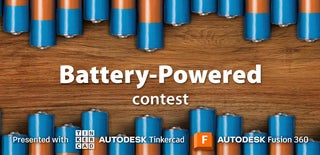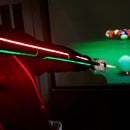Introduction: Wood LED Chess
In this instructable, I am building an LED chess set made of wood. Chess is one of the greatest games and a must do project for any woodworker. This my extra ordinary version of chess. Each chessmen contains an LED with 2 neodymium magnets. The positive and negative of the LED are connected to the oppossite poles of each magnet. The chess board uses 2 magnets per square (these are the leads) with opposite poles exposed on top of the board allowing chessman to make contact and connection to the leads only one way. To power the LEDS I use a lithium polymer battery, charging board, and switch. Here is how the process went and I hope you enjoy.
Supplies
This is the list of materials i used.
Materials:
- 5 minute epoxy
- Neodymium Magnets
- LEDS
- Super glue and cure
- Black Stain
- Wire
- Masking Tape
- Switch
- Battery charge board
- Conductive glue (I did not use this but it would make this project much easier)
- Lipo battery
- Teak Oil
Tools:
- Table saw
- Scissors
- Sander
- Sandpaper 80 and 120 grit
- Drill
- 1/8" drillbit
- 1/4" drillbit
- Scrap paper
- Pen/Pencil
- Square
- Multitool
- Sidecutter
Links:
Step 1: Step 1
For this chess set there will need to be an enclosure since electronics are involved. I use 1/4" plywood for this, sanded it 80 grit then 120 grit, and use a table saw to make the cuts. I also miter cut all of the edges since plywood was used. The dimensions are as follows:
(2) 4.5" squares (top and bottom)
(4) 1 1/2" by 5" rectangles (these are the sidewalls)
Step 2: Step 2
Draw your chessboard pattern proportional to the measurement used using a square on the top board. My checkers are each 1/2" by 1/2". Once that is done make a stencil with 2 holes spaced evenly that are centered in a checker. Use this stencil and a 1/4" drillbit to drill 2 holes (these are for your magnets) in each checker. Insert magnets into each the holes making them flush with the top of the board. Each checker will contain 2 magnets with each magnets poles facing opposite of each other.
Step 3: Step 3
Magnets loose their magnetism with heat so i was unable to solder the connections. I strung 2-3 strands of wire from the start of a row to the end of a row and sandwiched the wires with another magnet. If you have conductive glue, put a dab of that to hold the wire in place instead. There will be several spots where the leads need to overlap each other. When this occurs, use a couple small pieces of electrical tape to cover one of the leads and then cross over top with your wire. Connect all of the south pole magnets together and all the north together. The ends we will later connect to our battery, charge board, and switch.
Step 4: Step 4
Next we take one of the sidewalls and trace the c-charge port. I use a drill and a 1/4" drillbit to make the shape. I then made a small metal bracket support and attached it to 2 of the walls to hold the charge board in place. On another sidewall is where the switch will be installed. I sanded down a small piece of plywood to cover the plastic on the switch, then used a drill with 1/4 and a small piece of sandpaper for the switch opening. Now we are ready to add our battery.
Step 5: Step 5
The battery I'm using is a lithium polymer from a lantern. Since it will be a nice snug fit between the top and bottom of the chess board, I just use a bit of tape and epoxy putty to secure the battery in place. Connect the positive lead of the battery to one of your magnet poles. Connect the negative lead of the battery to one of the switch leads. Connect the other set of magnets to the other switch lead. Connect the battery positive lead to positive on the charge board and the battery negative lead to the negative on the charge board.
Step 6: Step 6
The charge board has a small led thats red when charging and blue when charged. To utilize this light I use a 1/8 bit to drill a hole in the top corner of the chess board right above where i have the charge board mounted. I then filled the hole with epoxy to use as a little window that lights up red or blue. We are now ready to assemble the enclosure. I use super glue and cure to put this together. The cure pretty much instantly cures the super glue.
Step 7: Step 7
After the enclosure is assembled, clean up your wood with some 80 and then 120 grit sandpaper. Once satisfied cover the top of the board with masking tape. Using a square make your marks for the checkers and draw your lines. You should have 64 square total. Use a knife and square to cut along all the lines thst were drawn. Remove every other piece of masking tape until you reach the end of the board and it looks like a checker board. Use black stain or dye to color the squares where the masking tape was removed but be careful not to flood with too much color or some bleeding will occur into your white squares. I used color on all of my enclosure. Let it dry and remove the rest of the masking tape.
Step 8: Step 8
Choose your chessmen designs or design your own. Keep in mind that these chessmen are being built with wood thin enough for light to shine through. The wood I use is birdseye maple from an old shelf. It was already starting to peel up in some spots so i just used a putty knife to get as deep as i could underneath the veneer all the way around the board. Then used a square and knife to trim off what i needed. Sand with 80 grit until your satisfied with the amount of light that shows through the wood and then sand with 120.
Step 9: Step 9
Once you have your chessmen design, draw them onto some paper. Fold the paper in half twice and then cut out your pattern. This will give you 4 identical shapes. This works for my queen, king, and pawn. The bishop, rook, and knight were slighlty different. Tape these 4 pieces consecutively to each other with masking tape. Use this as a stencil and transfer the pattern to wood.
Step 10: Step 10
Use masking tape to cover your veneer and cut out the patterns. Whereever there is an edge in the pattern I use a knife to score the wood. Do this on the wood side and let your masking tape stay intact. Use a needlenose pliers to bend the wood on each seam. Use super glue and cure assemble your chessmen into a 3d piece. Leave the bottom of the piece as this is where the LEDs will be installed. You should have 2 sets of 16 chessmen. (each set consists of a king, queen, (2) bishops, (2) knights, (2) rooks, and (8) pawns) Use super glue and cure to seal all edges and seams of the chessmen.
Step 11: Step 11
Choose your colors of leds and bend the leads as shown in the pictures. (shaped like sunglasses) Once you have 32 leds you are ready to add the magnets. Just as the chess board, each LED will get 2 magnets with opposite poles exposed. You also need to make sure all the positive leads of the LEDs are attached to the same magnet pole. Same goes for the negative LED lead. Use conductive glue to secure magnets in place and let sit overnight. For the larger chess pieces (king, queen, and bishop) I added an extra LED to help light up the whole chessmen. If you used conductive glue on the LEDs and magnets, and your not using 5 minute epoxy, you can insert them into your chessmen before you add epoxy. If you didnt use conductive glue and just used super glue and cure or are using 5 minute epoxy, LEDs and magnets should be inserted after the epoxy has cured.
Step 12: Step 12
Mix up some epoxy and fill your chessmen full. Once the LEDs cure, use a drillbit or dremel to remove just enough epoxy to fit your magnets and LED inside. Be sure to set the magnets perpendicular to the chessmen and just past flush so making contact to your battery leads wont be an issue. After you have them inserted, let the epoxy cure, and then fill the voids with epoxy putty.
Step 13: Step 13
It is now time to clean up your chessmen with some 80 grit sandpaper. I like the futuristic like look and sanded the edges of all the chessmen to just slightly expose some epoxy to allow more light through. Finish cleaning them up with 120 grit sandpaper.
Step 14: The Finish
Lastly we will be applying out finish to our chessmen and chess board enclosure. Clean all your finished pieces well and apply your favorite finish. One of my favortite finishes is teak oil and thats what I used. Apply the oil, let it absorb into the wood a minute or so and wipe clean. You are now ready to game on!

Second Prize in the
Battery-Powered Contest













